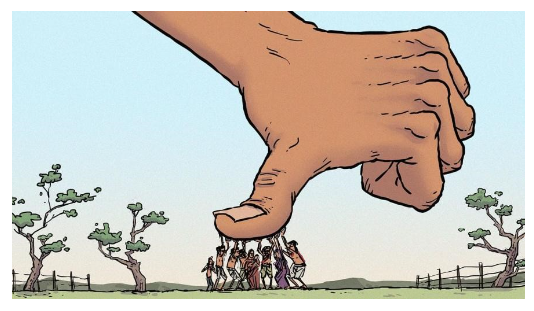Wednesday, 13th December 2023
Supreme Court Pronouncement: Article 370 Revocation
In News: The Supreme Court recently delivered a judgment on the Union government's 2019 initiative to modify Article 370 of the Constitution.
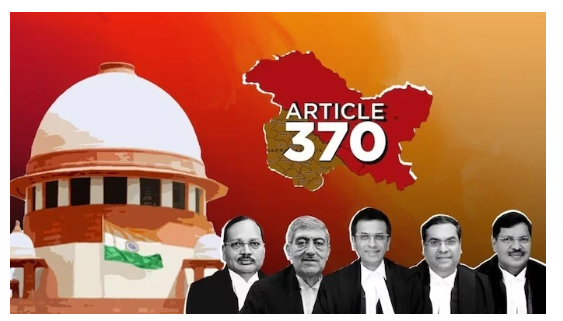
Landmark Supreme Court Verdict on Jammu and Kashmir: Sovereignty, Constitutionality, and Human Rights
- The Supreme Court determined that Jammu and Kashmir lacked sovereignty, citing Article 370 and the J&K Constitution.
- It emphasized that no merger agreement was needed to surrender sovereignty, and Article 370(1) applied Article 1 of the Indian Constitution without modifications.
- The court highlighted Section 3 of the J&K Constitution, stating the state's integral part in the Union.
- It deemed Article 370 temporary, placing it in Part XXI with transitional provisions.
- The Court upheld the President's power for irreversible changes during President's Rule, subject to judicial scrutiny.
- It rendered the J&K Constitution inoperative, as the Indian Constitution applied in its entirety.
- The judgment recommended establishing a Truth and Reconciliation Commission, akin to South Africa's post-apartheid model, for investigating human rights violations.
Evolution and Impact of Jammu and Kashmir's Special Status
- The special status of Jammu and Kashmir, established through Article 370 as a 'temporary provision' in 1949, granted the state the autonomy to draft its own constitution and limited the legislative powers of the Indian Parliament.
- The transformative moment came on August 5, 2019, when the President of India issued the Constitution (Application to Jammu and Kashmir) Order, modifying Article 370 but not revoking it.
- This move fundamentally altered the relationship between Jammu and Kashmir and the Indian Union.
- Introduced by N Gopalaswami Ayyangar, Article 370 empowered the J&K Constituent Assembly to recommend the application of specific Indian Constitution articles to the state.
- The subsequent dissolution of the assembly led to Clause 3 of Article 370, granting the President the authority to amend its provisions.
- Article 35A, emerging from Article 370, was introduced in 1954, empowering the Jammu & Kashmir legislature to define permanent residents and their special rights.
- The recent constitutional changes have nullified this special status, bringing Jammu and Kashmir more in line with the constitutional framework applicable to other states, while maintaining distinct regional guarantees codified in Articles 371 and 371A-I.
Transformative Constitutional Changes in Jammu and Kashmir: 2019 Reorganization
- The Constitution (Application to Jammu and Kashmir) Order, 2019, marked a historic shift, replacing the 1954 Presidential Order and paving the way for substantial alterations in the region's governance.
- The subsequent Jammu and Kashmir Reorganisation Bill, 2019, led to the creation of two new Union Territories: Jammu & Kashmir and Ladakh.
- Unprecedented in Indian history, this transformation included adjustments in political representation, with J&K retaining five Lok Sabha seats and Ladakh gaining one.
- The UT of Jammu and Kashmir acquired an Assembly, contrasting with Ladakh as a UT without legislature.
- Noteworthy changes included a transition from a Governor to a Lieutenant Governor for Kashmir, a reduced five-year term for the J&K Assembly, and legislative powers over land matters.
- The abolition of Jammu & Kashmir's special status brought an end to its separate constitution, flag, and anthem, ensuring citizens' alignment with the Indian Constitution and the inclusion of Fundamental Rights.
- Additionally, Article 360's applicability, the enforcement of all parliamentary laws, and the replacement of the Ranbir Penal Code with the Indian Penal Code signified a comprehensive overhaul.
- Importantly, the nullification of Article 35A, originating from Article 370, epitomized the significant constitutional changes implemented in Jammu and Kashmir.
Legal Challenges in the Abrogation of Article 370
Constitutional Challenges
- The 2019 Presidential order replaced the "Constituent Assembly of Jammu and Kashmir" with the "legislative Assembly of Jammu and Kashmir" for recommendations, altering the terms.
- Autonomy dilution under Article 370 without a Constitutional Amendment, avoiding a two-thirds majority in Parliament, was challenged in the Supreme Court.
- The conversion of Jammu and Kashmir into a Union Territory was contested for not being referred to the State Assembly, as required by Article 3.
- The Presidential order's concurrence requirement was met through the Governor during Governor's rule, raising concerns.
Federalism Issue
- The Instrument of Accession, likened to a treaty, presented a federalism challenge as a pact between sovereign entities.
- Historical reasons granting Jammu and Kashmir special status, as acknowledged in the Santosh Kumar case (2017).
- The SC's ruling in the SBI v Zaffar Ullah Nehru case (2016) highlighted that Article 370 couldn't be repealed without the Constituent Assembly's concurrence.
Signs of Improved Peace and Security in Jammu and Kashmir Post Article 370 Abrogation
- Reduction in Stone Pelting and Militancy
- Stone-pelting cases dropped significantly from 618 in 2019 to 222 in 2020.
- Injuries to security forces reduced from 64 in 2019 to 10 in 2021.
- Decrease in Civilian Injuries
- Incidents of civilian injuries from pellet guns and baton charges saw a remarkable decline, going from 339 in 2019 to 25 in 2021.
- Law and order situations improved, with only 20 reported incidents in 2022.
- Arrests of Militants and Over-Ground Workers (OGWs)
- There was a notable increase in the arrests of Over-Ground Workers (OGWs) associated with militant groups, rising from 82 in 2019 to 178 in 2021.
- Decline in Terrorist Acts
- A 32% decline in terrorist acts was observed from August 2019 to June 2022, compared to the preceding 10 months.
The Path Forward for Kashmir: A Comprehensive Approach
- 10-Year Strategy for 3Es
- Deploy a decade-long plan focused on Education, Employment, and Employability (3Es) to uplift Kashmir's socio-economic landscape.
- ‘Zero-Terror Incident' Plan
- Continue and strengthen the ongoing 'zero-terror incident' plan initiated in 2020, with the objective of achieving success by 2026.
- Embrace Gandhian Path of Non-Violence
- Adopt the Gandhian principles of non-violence and peace to address the legitimacy crisis in Kashmir, promoting dialogue and understanding.
- Comprehensive Outreach Programme
- Mitigate challenges arising from the changes in Article 370 by launching a comprehensive outreach program, fostering open communication and collaboration with all Kashmiris.
- Embrace Atal Bihari Vajpayee's Vision
- Uphold Atal Bihari Vajpayee's vision of "Kashmiriyat, Insaniyat, and Jamhooriyat" (inclusive culture, humanitarianism, and democracy) as a foundational framework for reconciliation and peace-building in the region.
- Forces of Reconciliation
- Encourage and support initiatives that promote reconciliation, inclusivity, and the spirit of democracy, making these values central to the resolution process.
|
UPSC Previous Year Questions Prelims (2020) Q. Siachen Glacier is situated to the (a) East of Aksai Chin Ans: (d) Prelims (2008) Q. Which one of the following is the largest (area wise) Lok Sabha constituency? (a) Kangra Ans: (b) Mains (2016) Q. To what extent is Article 370 of the Indian Constitution, bearing marginal note “Temporary provision with respect to the State of Jammu and Kashmir”, temporary? Discuss The future prospects of this provision in the context of Indian polity. Mains (2020) Q. Analyse internal security threats and transborder crimes along Myanmar, Bangladesh and Pakistan borders including Line of Control (LoC). Also discuss the role played by various security forces in this regard. Mains (2019) Q. The banning of ‘Jamaat-e-Islami’ in Jammu and Kashmir brought into focus the role of over-ground workers (OGWs) in assisting terrorist organizations. Examine the role played by OGWs in assisting terrorist organizations in insurgency affected areas. Discuss measures to neutralize the influence of OGWs. |
Source: IE
National Mission for Clean Ganga
In News: The National Mission for Clean Ganga (NMCG) has entered into a Memorandum of Common Purpose (MoCP) with the Mississippi River Cities and Towns Initiative (MRCTI).
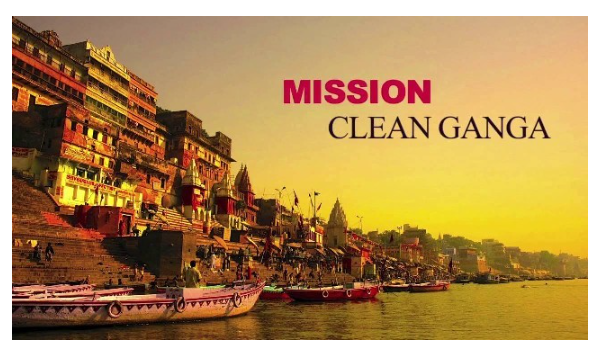
Mississippi River Cities and Towns Initiative (MRCTI)
- Overview
- Established in 2012, the MRCTI serves as a powerful advocate for the Mississippi River, amplifying the call for effective river protection, restoration, and management in Washington, DC.
- It addresses shared concerns such as river water quality, habitat restoration, flooding, sustainable economies, and the preservation of River culture and history.
River Cities Alliance (RCA)
- About
- The RCA, a collaborative initiative of the Ministry of Jal Shakti (MoJS) and the Ministry of Housing and Urban Affairs (MoHUA), aims to foster sustainable river-centric development.
- With a focus on Networking, Capacity Building, and Technical Support, it has expanded from 30 to 110 member cities in India and one international member city from Denmark since its inception in November 2021.
- Objective
- The RCA strives to facilitate online knowledge exchange among Indian cities for insights into innovative urban river management practices.
- It also provides an avenue for international cities to gain valuable perspectives from Indian experiences relevant to their contexts.
National Mission for Clean Ganga (NMCG)
- About
- Established on 12th August 2011, the NMCG operates as the implementation arm of the dissolved National Ganga River Basin Authority (NGRBA).
- Its primary objective is to combat pollution and rejuvenate the Ganga River.
- The Namami Gange program is a pivotal initiative under NMCG for Ganga rejuvenation.
- Organizational Structure
- The NMCG operates within a five-tier structure encompassing the National Ganga Council, Empowered Task Force (ETF) on river Ganga, State Ganga Committees, and District Ganga Committees.
- This hierarchical framework ensures coordinated efforts for pollution prevention, control, and abatement in the Ganga River.
|
UPSC Previous Year Questions Prelims (2014) Q. Consider the following statements:
Which of the statements given above is/are correct? (a) 1 only Ans: (b) Mains (2015) Q. Discuss the Namami Gange and National Mission for Clean Ganga (NMCG) programmes and causes of mixed results from the previous schemes. What quantum leaps can help preserve the river Ganga better than incremental inputs? |
Source: IE
AMRIT Technology - Edukemy Current Affairs
In News: The Ministry of Jal Shakti has provided updates on the advancements of the Jal Jeevan Mission and the Arsenic and Metal Removal by Indian Technology (AMRIT).
AMRIT Technology: Revolutionizing Water Quality
- AMRIT Technology, pioneered by the Indian Institute of Technology (IIT) - Madras, stands as a groundbreaking solution for tackling water quality concerns.
- Specifically designed for the removal of arsenic and metal ions from water, the technology utilizes nano-scale iron oxy-hydroxide to selectively eliminate arsenic as water passes through it.
- With applications for both domestic and community-level water purification, AMRIT aligns seamlessly with the overarching objectives of the Jal Jeevan Mission.
- This mission, dedicated to providing safe and potable tap water to rural households in India, recognizes AMRIT's potential in addressing critical water and sanitation challenges.
- The technology has earned endorsement from the 'Standing Committee' of the Department of Drinking Water and Sanitation, further emphasizing its importance in advancing water quality solutions.
Jal Jeevan Mission: Transforming Rural Water Access
- About
- Launched in 2019, the Jal Jeevan Mission aims to ensure safe and ample drinking water access to all rural households in India by 2024, in line with Sustainable Development Goal-6 (Clean Water and Sanitation).
- The mission targets the provision of 55 litters of water per person per day through Functional Household Tap Connections (FHTC) by 2024. Additionally, the Jal Jeevan Mission (Urban) extends this initiative to cover water supply in all 4,378 statutory towns across the country.
- Objectives
- Establishing secure tap and sewer connections.
- Rejuvenating water bodies.
- Creating a circular water economy.
- Progress of the Jal Jeevan Mission
- In August 2019, only 16.8% of rural households had tap water connections.
- By December 2023, this figure significantly increased to approximately 71.51%.
- All 378 arsenic-affected habitations, awaiting tap water supply, have reported receiving safe drinking water through Community Water Purification Plants (CWPPs).
|
UPSC Previous Year Questions Mains (2019) Q. What is water stress? How and why does it differ regionally in India? |
Source: PIB
Old Pension Scheme (OPS) Vs New Pension Scheme (NPS)
In News: Reverting to Old Pension Scheme (OPS) Could Pose Substantial Financial Strain on States, Warns RBI
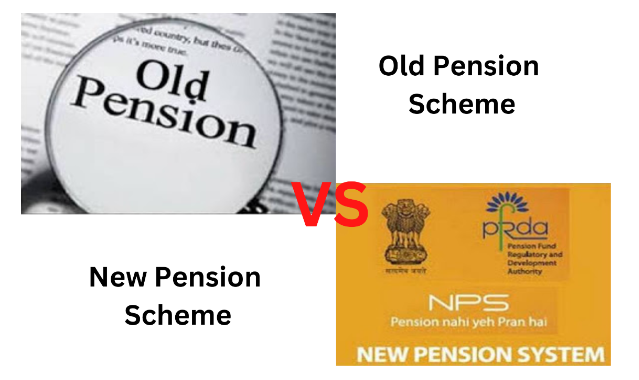
Old Pension Scheme (OPS)
- Overview
- OPS provides government employees with pensions based on their last drawn salary, constituting 50% of the final salary.
- It is recognized as a "Defined Benefit Scheme," assuring a predetermined benefit to retirees.
- Attraction of OPS
- The scheme's appeal lies in the promised certainty of benefits for retirees, exemplifying a guaranteed pension equal to 50% of the last drawn salary.
- This includes periodic increases aligned with dearness allowance adjustments.
- Discontinuation and Concerns
- OPS was discontinued by the Central government in 2003.
- One of its primary concerns was the unfunded pension liability, lacking a dedicated corpus for growing pension obligations.
- This 'pay-as-you-go' approach raised inter-generational equity issues and fiscal burdens.
- RBI's Fiscal Concerns
- The recent return to OPS by certain states, including Himachal Pradesh, Jharkhand, Punjab, Chhattisgarh, and Rajasthan, prompted the RBI to flag major fiscal concerns.
- The RBI warned against accumulating unfunded pension liabilities, emphasizing the risk of postponing current expenses to the future.
New Pension Scheme (NPS)
- Introduction
- Introduced in 2004 as an alternative to OPS, the NPS is open to employees from various sectors, excluding the armed forces.
- It encourages systematic investment in a pension account throughout one's employment.
- Retirement Benefits
- Upon retirement, NPS subscribers can withdraw a percentage of the accumulated corpus, while the remaining amount is disbursed as a monthly pension post-retirement.
- The Nodal agency overseeing NPS is the Pension Fund Regulatory and Development Authority (PFRDA).
Distinguishing NPS from OPS
- OPS as a Pension-Oriented Scheme
- OPS guarantees a fixed and constant pension amount, providing retirees with a predetermined benefit during their post-service years.
- NPS as an Investment cum Pension Scheme
- In contrast, NPS is an investment and pension scheme. It doesn't assure fixed returns, as benefits are subject to market fluctuations.
- While contributions are defined, the ultimate pension benefits depend on market dynamics, distinguishing it from the predictable nature of OPS.
Key Highlights from the "State Finances: A Study of Budgets of 2023-24" Report
- Return to OPS Challenges State Finances
- The reversion to the Old Pension Scheme (OPS) by certain states poses a substantial financial burden.
- If all states shift from the New Pension Scheme (NPS) to OPS, the cumulative fiscal burden could be 4.5 times that of NPS, reaching 0.9% of GDP annually by 2060.
- Tax Mop-up and Buoyancy
- Implementation of Goods and Services Tax (GST) contributes to increased tax buoyancy for states.
- Overall, states exhibit strong tax efforts, but improvement requires enhanced tax capacity through reforms and efficient tax administration.
- Potential for Revenue Enhancement
- States can boost non-tax revenues by revising user charges for electricity, water, and public services.
- Opportunities lie in optimizing royalties and premiums from mining activities.
- Better financial management of Public Sector Units (PSUs) can contribute to revenue growth.
- Controlled Revenue Expenditure
- Growth in revenue expenditure during April-September 2023-24 (8.9%) is significantly lower than the full-year budget estimate of 18%.
- This provides room for higher capital expenditure while maintaining fiscal consolidation.
- Prudent Fiscal Management for 2023-24
- States plan for prudent fiscal management, with a budgeted consolidated gross fiscal deficit (GFD) at 3.1% of GDP.
- Total outstanding liabilities are projected to decrease to 27.6% of GDP for 2023-24 from the peak of 31% in 2020-21.
- Some states may have outstanding liabilities higher than 30% of Gross State Domestic Product (GSDP).
Source: IE
Mummified Baboons - Edukemy Current Affairs
In News: For over a century, scientists have grappled with the mystery of the origin of mummified baboons in Egypt. Recently, researchers unveiled the secrets behind these ancient relics by employing mitochondrial DNA analysis.
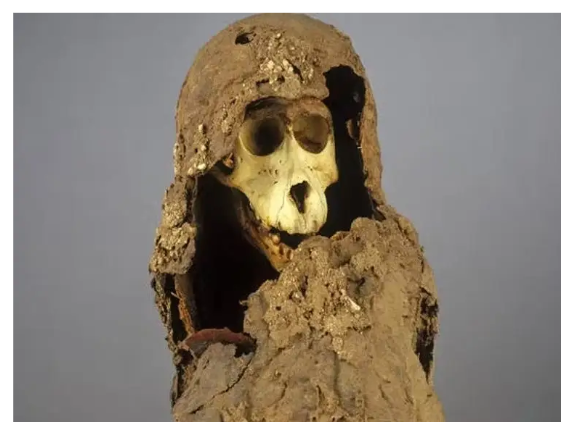
Unveiling Ancient Trade Routes: DNA Analysis Traces Mummified Baboons to Coastal Eritrea
- Recent DNA analysis has successfully traced the origin of mummified baboons to the ancient city of Adulis, situated in present-day coastal Eritrea.
- This study not only unravelled the mystery surrounding these baboons but also provided insights into the potential location of the lost city of Punt, a significant trading partner with ancient Egypt and Adulis.
- The findings underscored the historical trade relationships between Egypt and Adulis, highlighting the Red Sea as a crucial hub in the trade history connecting India, Egypt, and Europe.
- The baboons in question, belonging to the species Papio Anubis and Papio hamadryas, shed light on the Old-World monkeys' historical presence in this region.
- Papio Anubis, the more widely distributed baboon species, ranges across central sub-Saharan Africa.
- On the other hand, Papio hamadryas is found in the area of the southern Red Sea, specifically in Ethiopia, Somalia, and Eritrea. Both species, rated as "Lower Risk, Least Concern" by the IUCN Red List, play a fascinating role in unveiling ancient trade routes and connections in the Red Sea region.
Source: CNN
Radiocarbon Dating - Edukemy Current Affairs
In News: Archaeologists have employed radiocarbon dating to analyse East Asia's oldest true wooden frame saddle, shedding light on how advances in equestrian technology likely contributed to the rise of Mongolian steppe cultures.

About Radiocarbon Dating
- Radiocarbon dating, also known as carbon-14 dating, is a scientific technique capable of determining the age of organic materials up to around 60,000 years.
- Developed in the late 1940s by Willard Libby at the University of Chicago, this method relies on the decay of the carbon-14 isotope, a radioactive form of carbon.
- It has applications in historical studies and atmospheric science.
- The process involves the continuous formation of carbon-14 in the upper atmosphere through cosmic ray neutron interactions with nitrogen-14 atoms.
- This newly formed carbon-14 is then absorbed by plants and animals during their lifetimes.
- When these organisms die, the carbon-14 begins to decay into other atoms.
- By measuring the remaining carbon-14 atoms, scientists can estimate the time elapsed since the organism's death.
- With a half-life of approximately 5,730 years, carbon-14 undergoes decay, wherein half of the atoms in a sample transform into other atoms within that time frame.
- This fundamental principle enables researchers to determine the age of various organic materials, including remnants of animals, humans, plants, paper, leather, and even building materials like logs.
Source: PO
Indian Mouse Deer and Chousingha
In News: In a recent animal exchange initiative by the Indira Gandhi Zoological Park with Kakatiya Zoological Park in Warangal, IGZP welcomed two new species, Mouse Deer and Chousingha.

Indian Mouse Deer - Key Details
- Overview
- The Indian Mouse Deer, scientifically known as Moschiola indica, is the smallest deer species in India, known for its nocturnal behaviour.
- Distribution
- Endemic to the Indian Subcontinent.
- Mainly found in peninsular India, with historical records in Nepal.
- Sri Lanka has a distinct species called the spotted chevrotain (Moschiola meminna).
- Commonly encountered in various forest areas along the Western Ghats, Eastern Ghats up to Orissa, and central Indian forests.
- Features
- Small in size, measuring 25-30 cm at shoulder height, and weighing between two to four kg.
- Dark brown fur with white underparts.
- Characterized by four or five light rows of white spots on the back.
- Males possess tusk-like upper canines.
- Unique three-chambered stomach instead of the typical four-chambered stomach in ruminants.
- Forages on the forest floor for fruits, roots, leaves, herbs, and occasionally consumes insects, crustaceans, and small mammals.
- Conservation Status
- IUCN: Least Concern.
Chousingha - Key Facts
- Overview
- The four-horned antelope, or chousingha (Tetracerus quadricornis), is a small antelope native to India and Nepal.
- Distribution
- Endemic to the Indian subcontinent.
- Found in woodland areas across India.
- Features
- Smallest antelope species in Asia.
- Identified by four horns, distinguishing them from other bovids with two horns.
- Typically, diurnal and solitary, occasionally seen in loose groups of three to four.
- Sedentary animals, residing in the same region throughout their lives.
- Yellowish-brown to reddish coat, slender build, small legs, and a short tail.
- Conservation Status
- IUCN Red List: Vulnerable.
Source: TH
Kambalakonda Wildlife Sanctuary
In News: The inaugural Nature Interpretation Centre at the Eastern Ghats Biodiversity Centre, located on the outskirts of the Kambalakonda Wildlife Sanctuary in Visakhapatnam, is a unique facility.
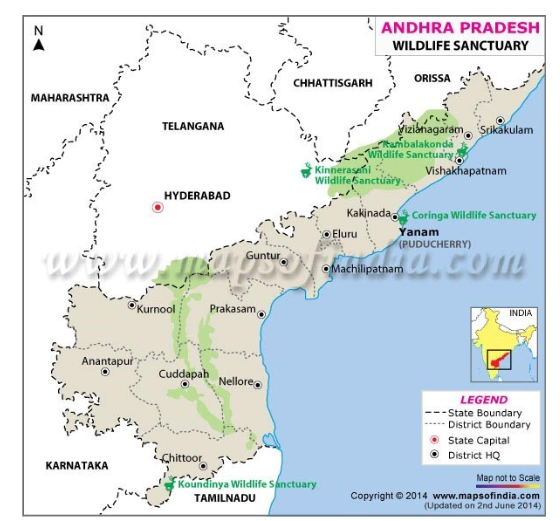
About Kambalakonda Wildlife Sanctuary
- The Kambalakonda Wildlife Sanctuary, situated in Andhra Pradesh, derives its name from the local hillock "Kambalakonda" and serves as a crucial green space for the residents of Vizianagaram.
- Characterized by hilly terrain with steep slopes, the sanctuary boasts dry evergreen forests, a unique and endangered forest type specific to Tamil Nadu and Andhra Pradesh.
- The diverse flora within the sanctuary includes notable species like Tectona grandis, Randia dumetorum, Grewaia tiliaefolia, and Abrus precatorius.
- The landscape features striking flowers such as the Indian screw tree, along with other blooms like those of the Bush plum tree and Jungle berry bunches.
- The wildlife in the sanctuary encompasses mammals like leopards, barking deer, and jackals, while the avifauna includes species like the paradise flycatcher, tree pie, quails, and partridges.
- The sanctuary serves as a vital habitat for various plant and animal species, contributing to the region's biodiversity.
Source: TH
What are Otolith rings? - Edukemy Current Affairs
In News: Marine biologists at the University of Southampton have devised a method to decipher the chemistry of otoliths.
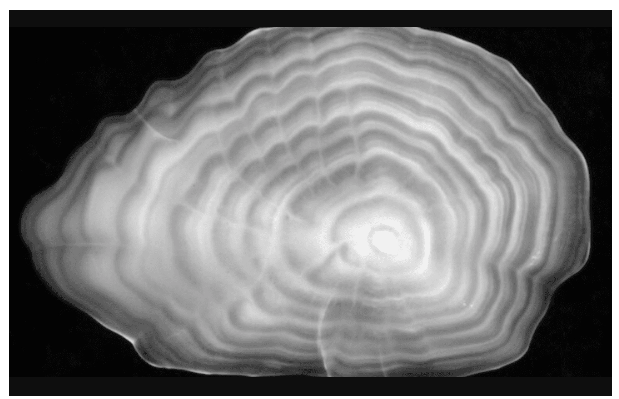
About Otolith rings
- Otoliths, commonly known as "earstones," are calcified structures in the ears of bony fishes, resembling tree rings that disclose a fish's age.
- The different isotopes of oxygen in otoliths indicate the fish's past temperatures, while carbon isotopes reveal energy conversion from food.
- The three types of otoliths—Sagitta, Asteriscus, and Lapillus—aid in balance and hearing.
- Otolith features assist in identifying fish species, size, age, growth rate, and time of death.
- Studying oxygen isotopes in otoliths provides insights into water temperatures, and trace element concentrations indicate water salinity levels.
Source: TH
Exercise VINBAX-2023 - Edukemy Current Affairs
In News: A contingent of 45 personnel from the Indian Armed Forces has recently arrived in Hanoi, Vietnam, to participate in the Joint Military Exercise VINBAX-2023.
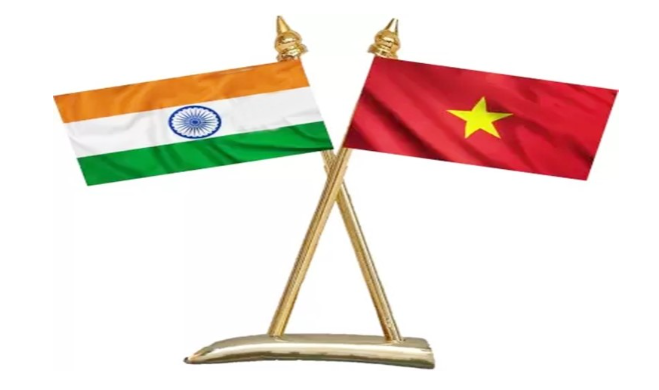
Exercise VINBAX-2023 Overview
- Exercise VINBAX-2023, initiated in 2018 with its inaugural edition in Jabalpur, Madhya Pradesh, is an annual training event alternately held in India and Vietnam.
- The previous edition took place at Chandimandir Military Station in August 2022, and the current exercise is being conducted in Hanoi, Vietnam.
- The participating Indian contingent consists of 39 personnel from a Bengal Engineer Group's Engineer Regiment and six personnel from the Army Medical Corps.
- The primary objective of VINBAX-2023 is to strengthen collaborative partnerships, enhance interoperability, and exchange best practices between the Indian and Vietnamese armed forces.
- Aligned with Chapter VII of the United Nations Charter on Peacekeeping Operations, the exercise focuses on conducting a Command Post Exercise cum Field Training Exercise.
- This involves the deployment and employment of an Engineer Company and a Medical Team, with an emphasis on technical military operations resembling scenarios encountered during the global deployment of United Nations contingents.
Source: PIB
Web Browsers - Edukemy Current Affairs
In News: Web browsers serve as our digital gateways to the expansive realm of the internet, simplifying our ability to navigate and reach web pages effortlessly with a simple click.

Understanding Web Browsers
- Overview
- A web browser is software designed to explore the World Wide Web (www), acting as an intermediary between the server and the client by requesting web documents and services.
- It functions as a compiler, rendering HTML (Hypertext Markup Language) to display web pages, including text, links, images, and additional elements such as stylesheets and JavaScript functions.
- Examples of Web Browsers
- Notable examples of web browsers include Google Chrome, Microsoft Edge, Mozilla Firefox, and Safari.
- Historical Background
- In the early days of the internet, browsing was text-based until Tim Berners-Lee introduced the World Wide Web in 1990, accompanied by the inaugural web browser, 'WorldWideWeb.'
- The transformative Mosaic browser in 1993 introduced images to the web landscape, leading to the 'Browser Wars' between Netscape Navigator and Internet Explorer.
- Evolutionary Leaps
- Mozilla Firefox in 2004-2005 broke the dominance of Internet Explorer, introducing innovations like tabbed browsing and add-ons.
- Google's Chrome emerged in 2008, revitalizing the browser market with its speed and minimalism.
- Other contenders like Apple's Safari and Microsoft Edge evolved, offering diverse options.
Anatomy of Web Browsers
- Request and Response
- Browsing initiates a digital communication sequence between servers, analogous to sending and receiving messages.
- Deconstructing the Response
- Webpage information arrives in HTML, CSS, and JavaScript files, each playing a vital role in constructing the final web page.
- HTML, CSS, and JavaScript
- HTML provides the architectural blueprint, defining the structure of the page.
- CSS acts as the interior designer, controlling aesthetics like color schemes and fonts.
- JavaScript adds dynamism, making pages interactive and responsive.
- Rendering
- The browser assembles the webpage by decoding HTML, applying CSS for aesthetics, and executing JavaScript for interactivity.
- Data Management
- Cookies store browsing data, while the cache retains frequently accessed files, enhancing page loading times.
- Security Measures
- Browsers employ encryption protocols like HTTPS and warning systems to ensure user safety.
The Future of Browsing
- As technology advances, browsers embrace cutting-edge technologies like WebAssembly for near-native performance.
- Support for Virtual Reality (VR) and Augmented Reality (AR) experiences is on the horizon.
- Privacy features are also being enhanced, providing users with more control over their digital footprint.
Web Browsers as Digital Architects
- Web browsers, often unsung heroes, translate code into dynamic web pages, forming the backbone of online experiences.
- Understanding the intricate processes underlying their operation enhances appreciation for the seamless magic they bring with every click.
|
UPSC Previous Year Questions Prelims (2019) Q. Consider the following statements: A digital signature is
Which of the statements given above is/are correct? (a) 1 only Ans: (c)
Mains (2020) Q: Discuss different types of cybercrimes and measures required to be taken to fight the menace. Mains (2015) Q: Discuss the advantages and security implications of cloud hosting of servers vis-a-vis in house machine based hosting for government businesses. Mains (2013) Q: What is a digital signature? What does its authentication mean? Give various salient built-in features of a digital signature. |
Source: TH
Universal Declaration of Human Rights
In News: Every year on December 10th, Human Rights Day is observed to mark the endorsement of the Universal Declaration of Human Rights (UDHR) by the UN General Assembly in 1948.
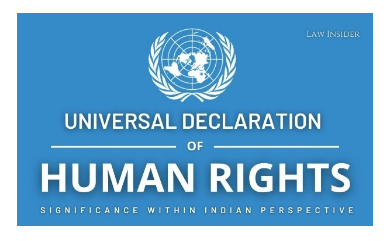
Understanding Human Rights
Human rights are fundamental entitlements belonging to every individual, irrespective of factors like race, sex, nationality, ethnicity, language, religion, or any other status. These encompass the right to life, liberty, freedom from slavery and torture, freedom of expression, the right to work and education, and more. As Nelson Mandela articulated, denying people their human rights challenges their very humanity.
Universal Declaration of Human Rights (UDHR)
- Overview
- The UDHR, adopted by the UN General Assembly in 1948, comprises 30 rights and freedoms encompassing civil, political, economic, social, and cultural aspects.
- It serves as a foundational document shaping the international order post-World War II.
- India's Role
- India actively participated in drafting the UDHR, aligning itself with the principles set forth in the declaration.
- Non-Binding Nature
- While the UDHR is not a legally binding treaty, its principles have been widely embraced and incorporated into the legal frameworks of numerous countries.
- International Bill of Human Rights
- Together with the International Covenant on Civil and Political Rights and the International Covenant on Economic, Social and Cultural Rights, the UDHR forms the International Bill of Human Rights, influencing global human rights standards.
Achievements of the UDHR
- Non-Binding Nature and Global Impact
- Although non-binding, the UDHR has catalyzed over 70 human rights treaties globally, influencing movements such as decolonization, anti-apartheid, and freedom struggles.
- Its broad acceptance prevented a fragmented landscape with varying standards.
Ongoing Relevance
- Despite criticisms, the UDHR's enduring relevance is evident in subsequent agreements, like the Vienna Declaration and Program of Action in 1993, which reinforced its principles.
- It remains a universal standard, fostering a shared understanding of human rights globally.
|
UPSC Previous Year Questions Prelims (2020) Q. Other than the Fundamental Rights, which of the following parts of the Constitution of India reflect/ reflects the principles and provisions of the Universal Declaration of Human Rights (1948)?
Select the correct answer using the code given below: (a) 1 and 2 only Ans: (d) |
Source: IE
India's Sustainable Future: Embracing BioCNG for Green Energy
In News: Unlocking the Potential of Biogas for a Sustainable Economy: A Commentary as presented in recent writeup.

Harnessing the Potential of BioCNG for a Sustainable Future: Insights
Introduction to BioCNG
BioCNG, or biomethane, stands as a renewable and eco-friendly fuel derived from upgrading biogas to natural gas quality. The process involves purifying biogas extracted from organic waste materials like agricultural residues, food waste, and sewage sludge.
Advantages of BioCNG
- High Calorific Value
- BioCNG boasts a high calorific value, ensuring increased energy production per unit volume compared to other fuels, making it efficient and cost-effective for various applications.
- Environmental Friendliness
- As a clean fuel, BioCNG contributes to reduced air pollution by emitting lower levels of harmful substances such as carbon monoxide, nitrogen oxides, and particulate matter compared to conventional fuels.
- Residue-Free and Smokeless
- BioCNG combustion produces no residue or smoke, distinguishing it as a non-polluting fuel, offering environmental and health benefits.
- Economic Viability
- BioCNG production from locally sourced waste materials aids in cost savings related to transportation and storage.
- It also promotes job creation and income opportunities at the local level.
- Bio-Fertilizer Generation
- BioCNG production can yield bio-fertilizers, enhancing soil quality and crop yields.
- The organic fertilizers are derived from the slurry or digestate left after BioCNG production.
Government's Vision for BioCNG
- CBG Blending Obligation (CBO)
- The government has introduced a mandatory blending of Compressed Bio-Gas (CBG) in Compressed Natural Gas (CNG) and Piped Natural Gas (PNG) segments.
- This initiative aims to promote CBG production and consumption in the country, with a gradual increase in blending percentages.
- Implementation of CBO
- The National Biofuels Coordination Committee (NBCC) oversees the mandate's implementation.
- The Ministry of Petroleum and Natural Gas (MoPNG) provides financial assistance and support to City Gas Distribution (CGD) companies.
- CGD companies are responsible for blending CBG in their CNG and PNG networks.
- Objectives of CBO
- Stimulate CBG demand in the CGD sector.
- Reduce Liquefied Natural Gas (LNG) imports, leading to forex savings.
- Promote a circular economy and contribute to achieving net-zero emissions.
Challenges in Implementing CBG Blending Obligation
- Feedstock Availability
- Ensuring a consistent and adequate supply of raw materials poses challenges, with factors like seasonality, regional variations, and market conditions impacting feedstock procurement.
- Infrastructure and Technology
- Developing and deploying the necessary infrastructure and technology for CBG production, storage, and distribution requires significant investment and faces barriers related to entry, exit, and regulatory compliance.
- Stakeholder Coordination
- Effective collaboration among stakeholders in the CBG value chain, including farmers, entrepreneurs, investors, regulators, and consumers, is essential but may encounter hurdles related to coordination, transparency, and accountability.
- Awareness and Acceptance
- Despite government campaigns, gaining public and industry acceptance of CBG as a viable alternative may face challenges tied to perception, trust, and resistance to change.
Conclusion
While BioCNG holds immense potential for a sustainable future, addressing these challenges requires concerted efforts from all stakeholders, emphasizing the importance of aligning economic, environmental, and social considerations in the pursuit of a green economy.
|
UPSC Previous Year Questions Prelims (2019) Q. Consider the following:
Which of the above are released into the atmosphere due to the burning of crop/biomass residue? (a) 1 and 2 only Ans: (d) |
Source: BL
Share the article
Edukemy’s Current Affairs Quiz is published with multiple choice questions for UPSC exams
MCQ
Get Latest Updates on Offers, Event dates, and free Mentorship sessions.

Get in touch with our Expert Academic Counsellors 👋
FAQs
UPSC Daily Current Affairs focuses on learning current events on a daily basis. An aspirant needs to study regular and updated information about current events, news, and relevant topics that are important for UPSC aspirants. It covers national and international affairs, government policies, socio-economic issues, science and technology advancements, and more.
UPSC Daily Current Affairs provides aspirants with a concise and comprehensive overview of the latest happenings and developments across various fields. It helps aspirants stay updated with current affairs and provides them with valuable insights and analysis, which are essential for answering questions in the UPSC examinations. It enhances their knowledge, analytical skills, and ability to connect current affairs with the UPSC syllabus.
UPSC Daily Current Affairs covers a wide range of topics, including politics, economics, science and technology, environment, social issues, governance, international relations, and more. It offers news summaries, in-depth analyses, editorials, opinion pieces, and relevant study materials. It also provides practice questions and quizzes to help aspirants test their understanding of current affairs.
Edukemy's UPSC Daily Current Affairs can be accessed through:
- UPSC Daily Current Affairs can be accessed through Current Affairs tab at the top of the Main Page of Edukemy.
- Edukemy Mobile app: The Daily Current Affairs can also be access through Edukemy Mobile App.
- Social media: Follow Edukemy’s official social media accounts or pages that provide UPSC Daily Current Affairs updates, including Facebook, Twitter, or Telegram channels.




